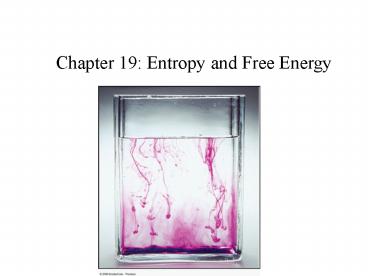Chapter 19: Entropy and Free Energy - PowerPoint PPT Presentation
1 / 10
Title:
Chapter 19: Entropy and Free Energy
Description:
Trends: Ssolids Sliquids Sgases. lighter molecules heavier molecules ... J/K not kJ, like enthalpies. Using Entropy Values. a) CaCO3(s) - CaO(s) CO2(g) ... – PowerPoint PPT presentation
Number of Views:130
Avg rating:3.0/5.0
Title: Chapter 19: Entropy and Free Energy
1
Chapter 19 Entropy and Free Energy
2
Thermodynamics
- will a reaction be spontaneous?
- H2O (s) -----gt H2O(l) spontaneous?
- H2O (l) -----gt H2O(s) spontaneous?
- 4Fe(s) 3O2(g) -----gt 2Fe2O3(s) spontaneous?
3
Change in Enthalpy (Review)
- ?Ho ?Hf(prod) - ?Hf(react)
- ?H negative exothermic ?H positive
endothermic - a) CaCO3(s) -----gt CaO(s) CO2(g)
- b) 4Fe(s) 3O2(g) -----gt 2Fe2O3(s)
- c) NaCl(s) H2O(l) -----gt NaOH(aq) HCl(aq)
4
Enthalpy as Predictor?
- in 1860s it was reported that enthalpy change
was a way to predict spontaneity. - similar to ?o values (?o gt 0 spontaneous)
- hypothesize ?H lt 0 spontaneous
- is this reasonable? N2 N2 I2
I2 - N2 I2 I2
- N2
- Spontaneous? Yes ?H 0
- N2 I2 I2 N2
- I2 I2 N2
- N2
- Also H2O (s) -----gt H2O(l) spontaneous? Yes
exothermic? No - Also, CaCO3(s) -----gt CaO(s) CO2(g)
- although not spontaneous at room temperature,
above 1200K becomes spontaneous
5
Change in Entropy, ?S
- entropy is a measure of disorder
- high entropy high disorder
- low entropy high order
- ?S ?So(products) - ?So(reactants)
- entropy of atom combination Appendix L Table 20
- Trends Ssolids lt Sliquids lt Sgases
- lighter molecules lt heavier molecules
- fewer molecules lt more molecules e.g. A
----gt 2B - NOTE UNITS! J/K not kJ, like enthalpies.
6
Using Entropy Values
- a) CaCO3(s) -----gt CaO(s) CO2(g)
- b) 4Fe(s) 3O2(g) -----gt 2Fe2O3(s)
- c) NaCl(s) H2O(l) -----gt NaOH(aq) HCl(aq)
7
Gibbs Free Energy, ?G
- for a reaction carried out at constant T P
- ? ?G ?H - T?S
- ?G lt 0 reaction is spontaneous
- ?G gt 0 reaction is not spontaneous
- ?G 0 reaction is at equilibrium
- Two factors tend to make ?G negative
- 1. negative ?H values
- 2. positive ?S values
8
Effect of Temperature on Reaction Spontaneity
- ?H ?S Value of ?G notes
- _ Always _ spontaneous at all T
- _ Always never spontaneous
- low T high T _ spontaneous only
at high T - _ _ low T - high T spontaneous only at low T
- ? ?G ?H - T?S
9
Using ?G to Predict Reaction Spontaneity
- a) CaCO3(s) -----gt CaO(s) CO2(g)
- ??? 178.0kJ ?S 0.1605kJ/K
- b) 4Fe(s) 3O2(g) -----gt 2Fe2O3(s)
- ?H -1648.4kJ ?S -0.5497kJ/K
- c) NaCl(s) H2O(l) -----gt NaOH(aq) HCl(aq)
- ?????60.5kJ ?S -0.0375kJ/K
10
Equilibrium
- at what temperature will a system be at
equilibrium? - ?G ?H - T?S 0
- ?H T?S
- ?H /?S T































